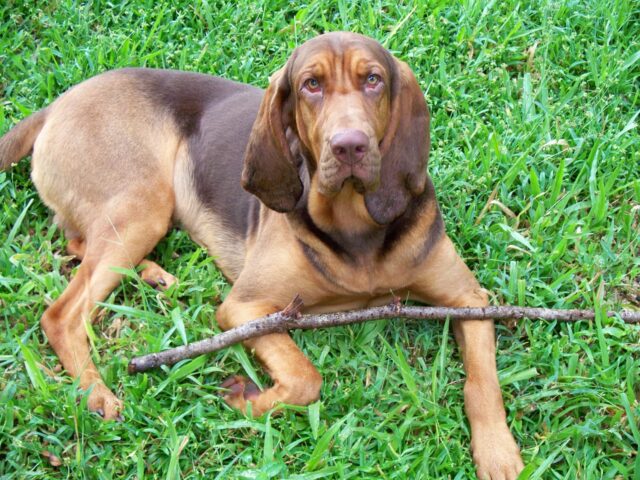Bloodhounds, with their droopy ears, soulful eyes, and unparalleled sense of smell, are iconic in the dog world. These large, affectionate hounds are known for their gentle nature and impressive tracking abilities, often seen with their noses to the ground following an interesting scent. Originating from France and Belgium, Bloodhounds have been used for centuries to track missing persons and even game. Their distinctive wrinkled faces and long, droopy ears are not just for show—they help trap scent particles, making Bloodhounds some of the best trackers around. Despite their serious working dog history, they are also incredibly loving and make great family pets. However, even these majestic sleuths have to slow down at some point. Typically, a Bloodhound is considered a senior around 7 to 9 years old, though this can vary depending on their health and lifestyle. As they age, Bloodhounds might swap their endless sniffing adventures for more leisurely activities and plenty of naps. Let’s explore the different stages of a Bloodhound’s life and see how these lovable detectives age with grace, humor, and a lot of drool.

1. The Puppy Phase: Tiny Detectives in Training
In the first year of a Bloodhound’s life, they are tiny, floppy-eared detectives in training. Bloodhound puppies are known for their playful and inquisitive nature, often seen exploring the world with their noses. This phase is characterized by a lot of energy, curiosity, and those adorable, oversized paws that they eventually grow into. Early training and socialization are crucial, as these puppies are intelligent and eager to learn but can also be quite independent. Despite their occasional clumsiness and a tendency to get into mischief, they are incredibly affectionate and form strong bonds with their families. The puppy phase is a time of joy and discovery, filled with playful antics and plenty of laughter.
2. The Adolescent Years: The Nose Knows
From around 1 to 2 years old, Bloodhounds enter their adolescent phase, often characterized by an increase in size and a deeper interest in the world of scents. Adolescent Bloodhounds are still playful and full of life, but they may also test boundaries as they explore their independence. This phase can be both challenging and entertaining, as they are highly intelligent and sometimes too clever for their good. Consistent training and plenty of physical and mental stimulation are key to managing their energy and keeping them well-behaved. Despite their sometimes stubborn nature, they are incredibly loyal and enjoy spending time with their families. This phase is a time of growth and learning, as Bloodhounds develop their unique personalities and deepen their bonds with their loved ones.
3. The Prime Years: Master Trackers and Loyal Companions
Between 2 and 7 years old, Bloodhounds are in their prime. These years are characterized by a balance of energy and maturity. Bloodhounds in their prime are confident and focused and enjoy engaging in various activities, from tracking exercises to leisurely walks. They are highly intelligent and enjoy mental challenges, making them excellent candidates for advanced training and scent work. This is also the time when their loyalty and affection for their families are most evident, making them excellent companions and watchdogs. Despite their sometimes serious demeanor, they are gentle and affectionate, often seeking out their humans for cuddles and companionship. The prime years are a time of adventure and bonding, with Bloodhounds bringing joy and a sense of purpose to every activity.
4. The Middle Ages: A Slower Pace
Around 7 to 9 years old, Bloodhounds start to enter their middle-aged years. During this time, they may begin to slow down slightly, preferring more moderate activities over the vigorous escapades they once enjoyed. This phase often brings a more relaxed attitude, although they still enjoy walks, playtime, and mental stimulation. Bloodhounds may start to show signs of aging, such as graying fur around the muzzle and a decrease in stamina. Despite these changes, they remain loyal and affectionate companions, enjoying the company of their families. Middle-aged Bloodhounds often become more content with a mix of activity and relaxation, making them perfect for households looking for a calm yet lively companion.
5. The Senior Years: Wise and Gentle Elders
By the time a Bloodhound reaches 7 to 9 years old, they are generally considered seniors. This phase is marked by a noticeable reduction in energy levels and a greater appreciation for rest and comfort. Senior Bloodhounds may develop age-related health issues such as arthritis, hip dysplasia, or vision problems like cataracts, which can affect their mobility and overall well-being. However, their loving and gentle nature remains unchanged, and they continue to bring joy and comfort to their families. They enjoy gentler activities, like leisurely walks and plenty of cuddle time in their favorite spots. Their bond with their human companions deepens, and they often become even more affectionate and devoted as they age.
Bloodhounds, with their unparalleled noses and gentle dispositions, bring joy and warmth to every stage of life. From the playful and curious puppy phase to the wise and loving senior years, these dogs are full of character, love, and a unique charm. While they may slow down as they age, their loyalty and affection for their families never waver. Each stage offers unique experiences and memories, making life with a Bloodhound a heartwarming journey. Whether they’re eagerly following a scent or enjoying a quiet day at home, Bloodhounds have a special way of making every moment memorable. So, cherish every stage with your Bloodhound, and enjoy the endless love and joy they bring into your life, from their floppy-eared beginnings to their golden years.
Frequently Asked Questions Someone Might Have About Their Aging Bloodhound

 Toledo, United States.
Toledo, United States.